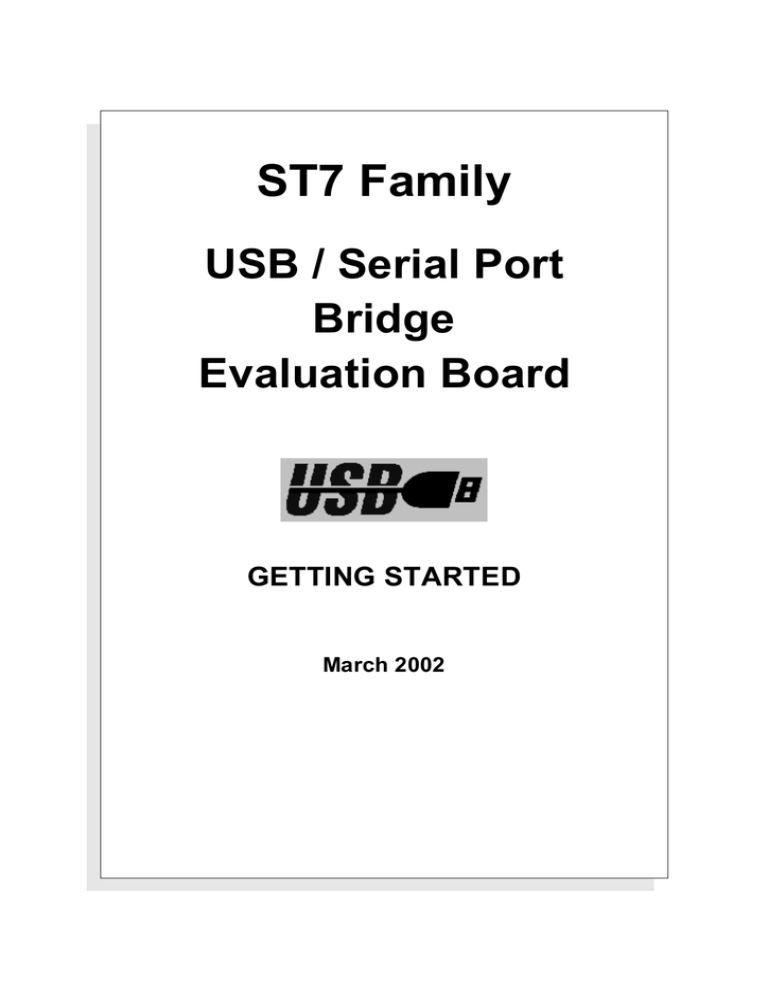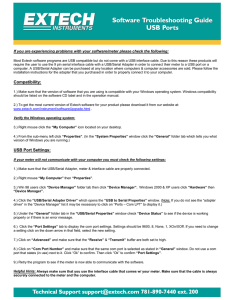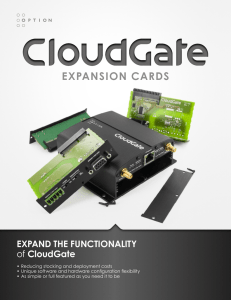
ST7 Family
USB / Serial Port
Bridge
Evaluation Board
GETTING STARTED
March 2002
USE IN LIFE SUPPORT DEVICES OR SYSTEMS MUST BE EXPRESSLY AUTHORIZED.
STMicroelectronics PRODUCTS ARE NOT AUTHORIZED FOR USE AS CRITICAL COMPONENTS IN
LIFE SUPPORT DEVICES OR SYSTEMS WITHOUT THE EXPRESS WRITTEN APPROVAL OF
STMicroelectronics. As used herein:
1. Life support devices or systems are those
which (a) are intended for surgical implant into
the body, or (b) support or sustain life, and
whose failure to perform, when properly used in
accordance with instructions for use provided
with the product, can be reasonably expected
to result in significant injury to the user.
1
2. A critical component is any component of a life
support device or system whose failure to
perform can reasonably be expected to cause
the failure of the life support device or system,
or to affect its safety or effectiveness.
ST72 USB MICROCONTROLLER
USB/Serial Port Bridge Evaluation Board
INTRODUCTION
The objective of the USB/Serial Port Bridge Evaluation Board is to provide you with a complete
reference design for a serial port bridge. This application is used to interface between devices
with a serial port (RS-232 type) and a host computer USB port. USB data transfers comply
with HID-class protocols.
The bridge is based on a USB low-speed microcontroller manufactured by STMicroelectronics
which provides a maximum USB transfer rate of 800 bytes per second. Flow control has therefore been implemented to ensure data transfer integrity when interfacing with the serial port at
rates up to 57600 bits per second (bps).
The bridge application is evaluated on a PC by running a dedicated applet that controls and
monitors data transfers on both the USB and serial COM ports.
The included hardware provides In-Circuit Programming (ICP) capabilities for the microcontroller. This is used to modify certain firmware parameters for evaluation or customization purposes.
The following development tools can be ordered separately: assembler, linker, C compiler,
source level debugger, hardware emulator, programming boards and gang programmer. For
ordering information, see our website at http://mcu.st.com or contact your local sales office.
Rev. 1.1
March 2002
3/14
1
Table of Contents
INTRODUCTION . . . . . . . . . . . . . . . . . . . . . . . . . . . . . . . . . . . . . . . . . . . . . . . . . . . . . . . 3
1 GETTING STARTED . . . . . . . . . . . . . . . . . . . . . . . . . . . . . . . . . . . . . . . . . . . . . . . . . . 5
1.1 SYSTEM REQUIREMENTS . . . . . . . . . . . . . . . . . . . . . . . . . . . . . . . . . . . . . . . . . 5
1.2 PACKAGE CONTENTS . . . . . . . . . . . . . . . . . . . . . . . . . . . . . . . . . . . . . . . . . . . . 5
1.3 SOFTWARE INSTALLATION . . . . . . . . . . . . . . . . . . . . . . . . . . . . . . . . . . . . . . . 5
1.4 HARDWARE INSTALLATION . . . . . . . . . . . . . . . . . . . . . . . . . . . . . . . . . . . . . . . 6
1.4.1 Power Supply . . . . . . . . . . . . . . . . . . . . . . . . . . . . . . . . . . . . . . . . . . . . . . . . . . . . . . . 6
1.4.2 Data Transfer via PC Serial Port . . . . . . . . . . . . . . . . . . . . . . . . . . . . . . . . . . . . . . . . 7
1.4.3 In-Circuit Programming (ICP) . . . . . . . . . . . . . . . . . . . . . . . . . . . . . . . . . . . . . . . . . . . 7
2 RUNNING THE USB/SERIAL PORT BRIDGE EVALUATION BOARD . . . . . . . . . . . 8
2.1 INTRODUCTION . . . . . . . . . . . . . . . . . . . . . . . . . . . . . . . . . . . . . . . . . . . . . . . . . 8
2.2 USB/SERIAL PORT BRIDGE EVALUATION PROGRAM . . . . . . . . . . . . . . . . . 9
2.2.1 Device Selection . . . . . . . . . . . . . . . . . . . . . . . . . . . . . . . . . . . . . . . . . . . . . . . . . . . . 9
2.2.2 Data Transfers . . . . . . . . . . . . . . . . . . . . . . . . . . . . . . . . . . . . . . . . . . . . . . . . . . . . . 10
2.3 USB/SERIAL PORT BRIDGE EVALUATION BOARD DIAGRAM . . . . . . . . . . 12
3 REVISION HISTORY . . . . . . . . . . . . . . . . . . . . . . . . . . . . . . . . . . . . . . . . . . . . . . . . . 13
14
4/14
1
USB/Serial Port Bridge Evaluation Board
1 GETTING STARTED
1.1 SYSTEM REQUIREMENTS
In order to use the USB/Serial Port Bridge Evaluation Board with the Windows operating
system, a recent version of Windows, such as Windows 98, Windows Millennium or Windows
2000 must be installed on the PC.
The version of the Windows OS installed on your PC may be determined by clicking on the
“System” icon in the Control Panel.
IMPORTANT: When running the HID evaluation board applet provided in the package, verify
that the correct version of the HID.dll file is installed:
– Windows
– Windows
– Windows
– Windows
98: HID.dll - Version 4.10.1998
98 SE: HID.dll - Version 4.10.2222
Millennium: HID.dll - Version 4.90.300.1
2000: HID.dll - Version 5.00.2134.1
For other operating systems, please refer to the CD-ROM for more information.
1.2 PACKAGE CONTENTS
The USB/Serial Port Bridge Evaluation Board includes the following items:
■
Hardware content:
– One ST72F623F2B1 Low-speed USB microcontroller device (DIP20 package).
This is a FLASH device allowing up to 100 reprogramming cycles. The ST72F623F2B1 is
delivered already programmed with the evaluation firmware.
– One evaluation board.
■
Software content (Contact the Sales Office or www.st.com for the most recent version)
– PC executable software for evaluating the USB/Serial Port Bridge. The source file, written
in Delphi, is provided as an application example using the HID driver.
– ST7 firmware (C source code) for the ST72F623F2B1 (HiWare Compiler)
■
Documentation (Contact the Sales Office or www.st.com for the most recent version)
– USB Library Interface documentation (Version 4.x).
– ST7262 and ST7261 Datasheets.
– Application Note AN1071.
1.3 SOFTWARE INSTALLATION
Install the Bridgels.exe file on your computer.
5/14
USB/Serial Port Bridge Evaluation Board
1.4 HARDWARE INSTALLATION
Figure 1 shows the location of the main components of the evaluation board. The schematic
drawing is given in “USB/Serial Port Bridge Evaluation Board Diagram” on page 12.
Figure 1. Evaluation Board Layout
ST72623F2B1 or
ST72611F1B1
USB to Serial Port Transfer Active LED
Serial Port to USB Transfer Active LED
Pin 1
ICP Connector
ST3232
RS-232 Connector
Reset Button
USB Connector
& Supply
1.4.1 Power Supply
The USB/Serial Port Bridge Evaluation Board is directly supplied by the USB Connector (buspowered) and therefore does not require an external voltage supply.
6/14
USB/Serial Port Bridge Evaluation Board
1.4.2 Data Transfer via PC Serial Port
When connected to a PC serial port for data transfer purposes, a DTE (Data Terminal Equipment) to DTE configuration is required. As a result, a cross-wired RS-232 cable must be used
as shown in Figure 2.
The USB/Serial Port Bridge Evaluation Board is equipped with two LEDs that display the data
transfer status:
– Orange LED: Serial Bus to USB transfer is active,
– Green LED: USB to Serial Bus transfer is active.
Figure 2. USB/Serial Port Connection Diagram
1
2
3
4
5
6
7
8
9
Rx
Rx
Tx
Tx
RTS
RTS
CTS
CTS
1
2
3
4
5
6
7
8
9
1.4.3 In-Circuit Programming (ICP)
The 10-pin connector must be connected to an ST7MDTU2-EPB tool in order to program or
erase the microcontroller Flash memory.
Note that the USB cable must be plugged in to supply the board with voltage.
7/14
USB/Serial Port Bridge Evaluation Board
2 RUNNING THE USB/SERIAL PORT BRIDGE EVALUATION BOARD
2.1 INTRODUCTION
The USB/Serial Port Bridge Evaluation Board consists of two main parts:
– the physical board,
– the USB-to-Serial Port Evaluation software running on your PC.
First connect the evaluation board to the PC via the USB cable. As a result, the evaluation
board is enumerated as a USB HID device as shown Figure 3, and is ready to use. You may
be required to insert your Windows CD-ROM.
Figure 3. Enumeration Result
When you start the USB/Serial Port Bridge Evaluation Program on the PC, a graphical interface is displayed for controlling and monitoring the data transfers on the USB and serial ports
of the PC. This PC software is also used to evaluate the enumeration process and to set the
communication parameters.
8/14
USB/Serial Port Bridge Evaluation Board
2.2 USB/SERIAL PORT BRIDGE EVALUATION PROGRAM
2.2.1 Device Selection
2.2.1.1 USB Enumeration
The Device Selection window, shown in Figure 4, displays the following information:
– Available USB HID devices
All USB HID devices connected to the PC are displayed in this window. Device data is
based on the Report ID. The ST7 USB/Serial Port Bridge will be displayed if the enumeration has been successfully completed.
– Device information
This information, obtained during the enumeration phase, refers to the highlighted device
in the “Available USB HID Device” window: Vendor ID, Product ID and Version numbers.
(Refer to the USB Specification version 1.1 or higher). Additionally, as string information
is supported, the Manufacturer name, Product and Serial Number are displayed.
2.2.1.2 COM Port Settings
This function selects the COM port used by the USB/Serial Port Bridge Evaluation Program to
emulate a serial port communication. When “None” is selected, the serial port can be managed by any other application on the same PC or by another PC.
2.2.1.3 Common Settings
This function is used to select the baudrate of the bridge in the bridge firmware.
If the applet is used to emulate the serial port, it also configures the COM port of the PC. Otherwise, the serial port baudrate must be defined at the same value in the other applet or device.
9/14
USB/Serial Port Bridge Evaluation Board
Figure 4. Device Selection Window
2.2.2 Data Transfers
2.2.2.1 Serial Port
The two following items do not apply if None has been selected in the “COM Port Setting” box
of the Device Selection window.
– PC Flow Control defines the flow control method used by the COM port when the applet
controls the COM port of the PC.
– Automatic received (USB) to sent (Serial) comparison verifies that the data received
by the USB port is equal to the data sent by the COM port of the PC.
– Loop: Send Serial, Receive USB is used to perform serial to USB transfers in Loop
mode. Unchecking this box during the data transfer will abort the transfer.
If the serial port is handled by another applet or PC, the Automatic received... box must not
be checked and the Loop box must be checked, depending on the required configuration.
10/14
USB/Serial Port Bridge Evaluation Board
2.2.2.2 USB Port
These items are validated only if the bridge is connected to the USB port.
– Hardware Flow Control done by bridge is used to enable/disable the RTS/CTS flow
control performed by the bridge on the serial port.
– Automatic received (Serial) to sent (USB) comparison verifies that the data received
by the serial port is equal to the data sent by the USB port.
– Loop: Send USB, Receive Serial is used to is used to perform USB to serial transfers in
Loop mode. Unchecking this box during the data transfer will abort the transfer.
Figure 5. Data Transfer Window
11/14
USB/Serial Port Bridge Evaluation Board
2.3 USB/SERIAL PORT BRIDGE EVALUATION BOARD DIAGRAM
12/14
USB/Serial Port Bridge Evaluation Board
3 REVISION HISTORY
Table 1. Summary of Modifications
Revision
Date
Modification
1.0
January 2002
First Issue
1.1
March 2002
Modification of Section 2.3 USB/Serial Port Bridge
Evaluation Board Diagram and addition of Section 3
Revision History.
13/14
USB/Serial Port Bridge Evaluation Board
NOTES:
Information furnished is believed to be accurate and reliable. However, STMicroelectronics assumes no responsibility for the consequences
of use of such information nor for any infringement of patents or other rights of third parties which may result from its use. No license is granted
by implication or otherwise under any patent or patent rights of STMicroelectronics. Specifications mentioned in this publication are subject
to change without notice. This publication supersedes and replaces all information previously supplied. STMicroelectronics products are not
authorized for use as critical components in life support devices or systems without the express written approval of STMicroelectronics.
The ST logo is a registered trademark of STMicroelectronics
2002 STMicroelectronics - All Rights Reserved.
Purchase of I2C Components by STMicroelectronics conveys a license under the Philips I2C Patent. Rights to use these components in an
I2C system is granted provided that the system conforms to the I2C Standard Specification as defined by Philips.
STMicroelectronics Group of Companies
Australia - Brazil - Canada - China - Finland - France - Germany - Hong Kong - India - Israel - Italy - Japan
Malaysia - Malta - Morocco - Singapore - Spain - Sweden - Switzerland - United Kingdom - U.S.A.
http://www.st.com
14/14



